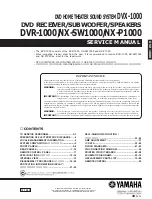
8
III. Operation
A. Installation
1. The water supply should be sufficient to provide a minimum of
20 psig pressure at the design feed flow.
2. Proper pretreatment must be determined and installed prior to
the RO system.
3. A fused high voltage disconnect switch located within 10 feet of
the unit is recommended. This disconnect is not provided with
the RO system.
4. Responsibility for meeting local electrical and plumbing codes
lies with the owner /operator.
5. Install indoors in an area protected from freezing. Space al-
lowances for the removal of the membranes from the pressure
vessels should be provided. This system requires 42" minimum
clear space on each side.
B. Plumbing Connections
1. Connect the pretreated feed water line to the inlet side of the
prefilter housing. (Figure # 1 item # 1) A feed water shutoff valve
should be located within 10 feet of the system.
2. Temporarily connect the outlet of the product water flow meter
to drain. (Figure # 1 item # 2) The product water line should
never be restricted. Membrane and/or system damage may oc-
cur if the product line is blocked.
3. Connect the outlet of the reject water flow meter to a drain. (Fig-
ure # 1 item # 3) The reject drain line should never be restricted.
Membrane and/or system damage may occur if the reject drain
line is blocked. An air gap must be located between the end
of the drain line and the drain. The use of a standpipe or other
open drain satisfies most state and local codes and allows for
visual inspection and sampling.
C. Electrical Connections
1. A safety switch or fused disconnect should be installed within 10
feet of the system.
2. Verify that the disconnect switch is de-energized using a
voltmeter.
3. Connect the outlet of the disconnect switch to the terminals on
top of the motor starter (Figure # 2). Attach the power supply
ground to the chassis ground. It may be necessary to drill a hole
in the enclosure and install a water tight strain relief or conduit
connector. The hole size and location must be determined by
the installer. Check the pump motor nameplate for the amper-
age draw at various voltages to determine the wire size required.
4. Do not apply power to the RO unit at this time.
D. Startup
1. Verify that the pretreatment equipment is installed and working
properly. Verify that no free chlorine is present in the feed water.
2. Verify that the pump discharge valve (Figure # 1 item D) is open.
3. Install a 20" five micron filter cartridge in the prefilter housing.
(Figure #1 item K)
4. Open the reject control valve completely (Figure # 1 item B) by
turning it counterclockwise. Close the reject recycle control valve
completely (Figure # 1 item C) by turning it clockwise.
5. Open the feed water shutoff valve installed in step III-B-1 above.
6. Manually open the inlet solenoid valve (figure #1 item L) by
turning the white lever located near the valve outlet.
7. Water will flow through the system and to drain through the
reject flow meter (figure # 1 item H).
8. Manually close the inlet solenoid valve after the air has been
purged from the system, or after 10 minutes, whichever
occurs first.
9. Close the pump discharge valve half way. (Figure # 1 item D)
10. Engage the safety switch or disconnect (installed in step III-C-1
above) to apply electrical power to the RO system.
11. Press the on/off button on the controller. When the pump starts,
press and hold the on/off button to turn off the pump and look
at the motor fan as the pump stops to determine if the pump ro-
tation is correct. See the controller section for more details. The
fan should rotate in the direction of the rotation arrow located
on the pump. Continue with the startup if the pump is rotating in
the proper direction. If the pump is rotating backwards, change
the rotation by disconnecting the power and reversing any two
of the wires on the power inlet. Verify proper pump rotation
before continuing.
12. Turn the system on.
13. Adjust the reject control valve(s) (figure # 1 items B & C) and
the pump discharge valve (Figure # 1 item D) until the desired
flows are achieved. Closing the reject valve increases the
product flow and decreases the reject flow. Opening the pump
discharge valve increases both the reject flow and the product
flow. See the flow rate guidelines and temperature correction
table in the appendix to determine the flow rates for different
operating temperatures.
14. Allow the product water to flow to drain for 30 minutes.
15. Turn off the system and connect the product line to the point of
use. (Figure # 1 item # I) The product water line should never be
restricted. Membrane and/or system damage may occur if the
product line is blocked.
16. Restart the system and record the initial operating data using the
log sheet in the next section.
See the controller section of this manual for more installation
and operation information.
NOTICE
It is the responsibility of the end user to ensure that the
installation is done according to local codes and regulations.
NOTICE
It is the responsibility of the end user to ensure that the
installation is done according to local codes and regulations.
NOTICE
Summary of Contents for Pure Water PWR4021 Series
Page 6: ...6 Figure 2 B Controller Drawing...
Page 7: ...7 B Controller Drawing continued Figure 3...
Page 13: ...13 Figure 6 Wiring Diagram Pictorial Schematic of a Typical ROC 4 System...
Page 15: ...15 Figure 8 Controller Detail Terminal Board TB 3 See Fig 3 for schematic TB24V3...
Page 20: ...20 Figure 11 Controller Programming Menu Navigation...
Page 31: ...31 Notes...









































